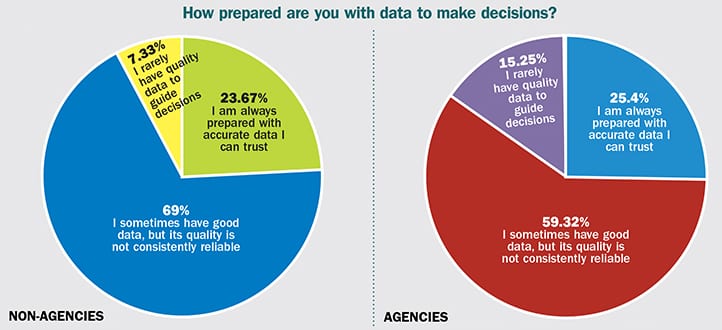
At year’s end it’s traditional to seek trends and look ahead. One trend that might slip by unnoticed is communicators’ higher regard for data collection and measurement. In addition, communicators increasingly are using data to garner insights about how to improve their efforts. Evidence for these observations comes from "The State of Data-Driven Communications," a recent survey of some 400 communicators from PR News and PublicRelay, a media monitoring and analytics firm. The survey was conducted in September and October, with 85% of respondents being U.S. based. [For a copy of the report please click here.]

As you can see in the chart above, an overwhelming majority (83%) say CEOs or executives are either asking for more data-driven analysis or asking them to prepare to provide it. In addition, the next charts show 82% of non-agency communicators and 81% of agency communicators say they are either spending more time on data and analysis this year vs. 2017 or the same amount of time.


The Digital Age
One reason for the rise of communications measurement is rooted in the digital age. Similar to just about every other field, communications is employing a great deal of digital technology. As a result, communicators' efforts generate a plethora of data. This means communicators can measure nearly everything they do on behalf of a brand or organization. This availability of data has helped push up measurement on communicators' priority list.
Another reason for measurement’s higher profile with communicators is that executives in other departments, such as finance and risk assessment, are saying, “ ‘Hey, we need to put a value on [communications] and we can put a value on it,’ ” says measurement guru Katie Paine. The C-Suite is looking at what communications does to help mitigate risk, provide lift to sales and assist with recruitment and retention, for example. For years, collecting and measuring data was considered more of a burden than a way to establish communications as a strategic contributor to businesses and nonprofit organizations.
Data and Insights
In addition, the study with PublicRelay indicates communicators are not merely collecting and measuring data, but seeking insights from it. As you see in the next two charts, a majority of communicators say they want more insight from data they’re collecting.

Says Kevin Winston, principal communications business partner at Genentech/Roche, “Measurement used to be about numbers of clips and share of voice…communicators rarely used data to gain insights. There’s no question. The tide is changing.”
PublicRelay’s CEO Eric Koefoot agrees. “We’re seeing an upsurge in the marketplace for insight from data. There’s definitely a wind at our back.”
Issues
Not every metric in the survey was upbeat, however. As you can see in the next charts (below), though digital technology throws off a surfeit of data, quality remains an issue. “83 percent of the people don’t have reliable data,” Koefoot says, referring to the responses from non-agency communicators in the chart on the left. “That’s a problem and it’s scary. How can you manage without good data?”

Adds Matt Anchin, CCO at Consumer Reports, “This lack of confidence in the data is indicative of how far we have yet to go as a profession in terms of our ability to sort and leverage data in a truly scientific and applied way.”
The next chart (below) shows that communicators feel the biggest measurement pain point relates to the lack of training on automated tools. The lack of training inhibits communicators from garnering insights from data. “That’s on the providers, all of us,” Koefoot says. “If we have a tool and we’re not providing enough training, shame on us. We’re not supporting the industry well,” he says.

Anchin adds, “Perhaps the balance between art and science in this profession is a little out of whack.” It’s great to have automated tools for data collection, but more than training in how to use the tools, you need people who possess an awareness of data’s value and “where you should push for more and better.”
Still, the prognosis for communications measurement is upbeat. Says Anchin, “The existential threat where marketers were six to 10 years ago is where the leaders of our profession are today. The decisions you make, the strategies you design and the results you deliver, if they’re not data-driven, especially in a world where so much data is readily available, you’re not going to be in a good place.” [For a copy of the report please click here.]
